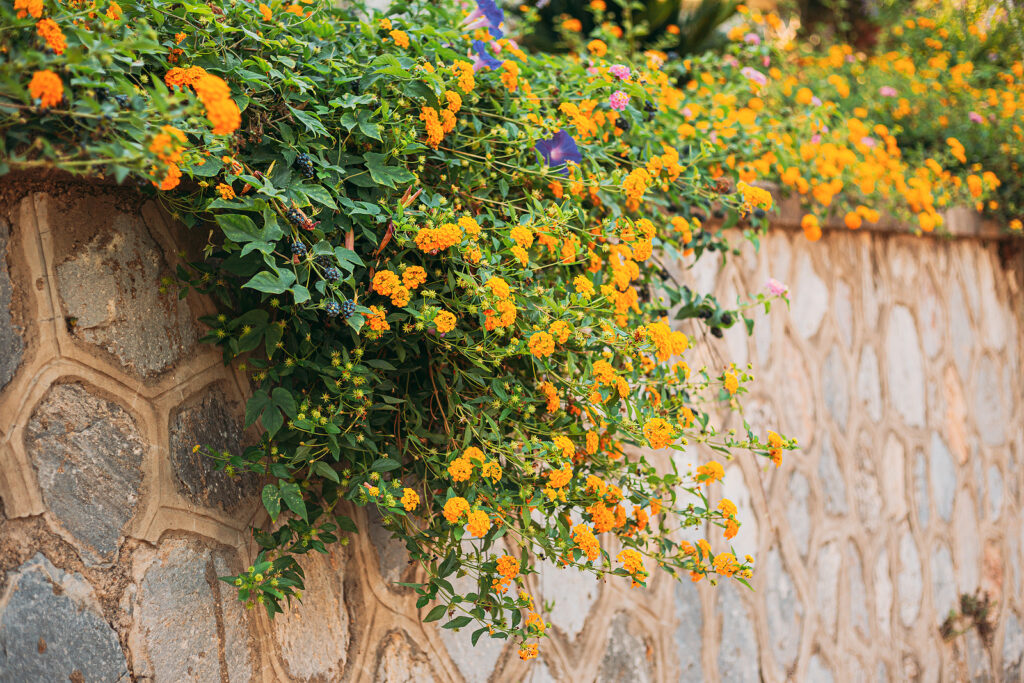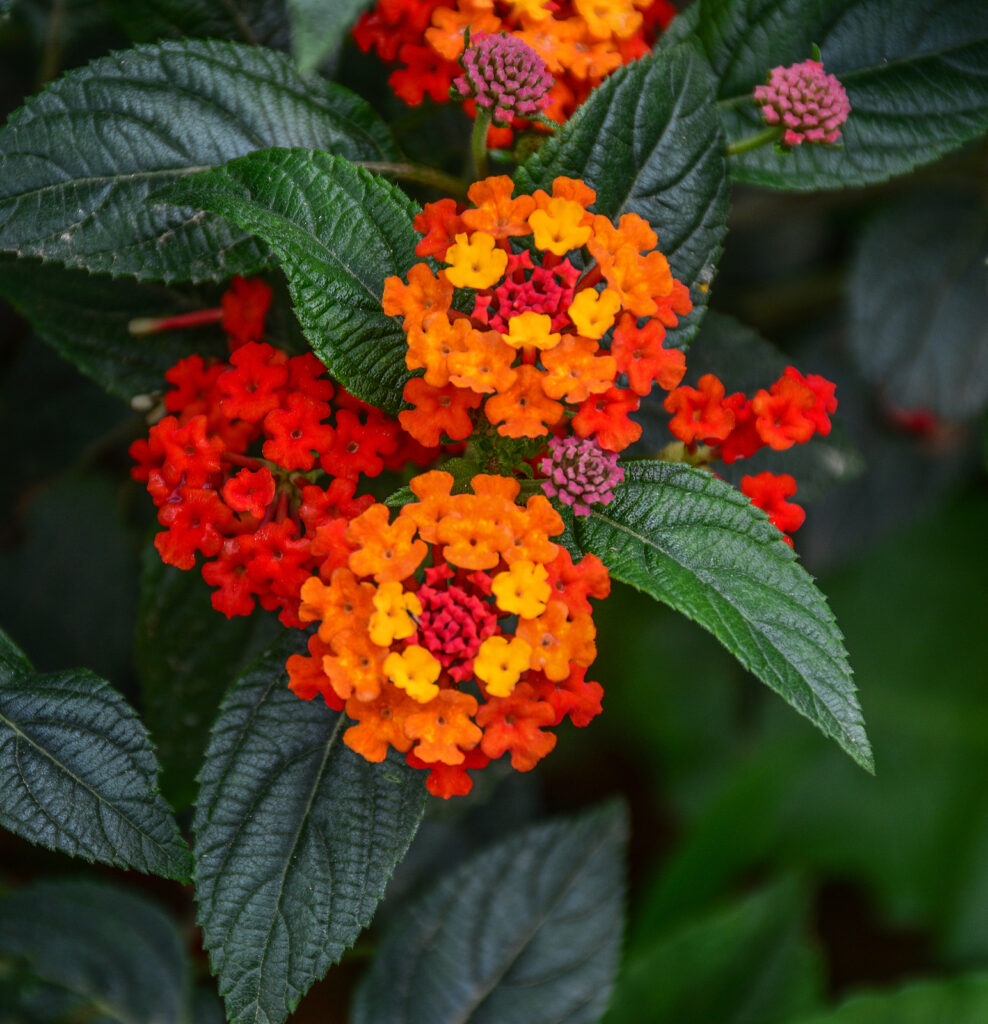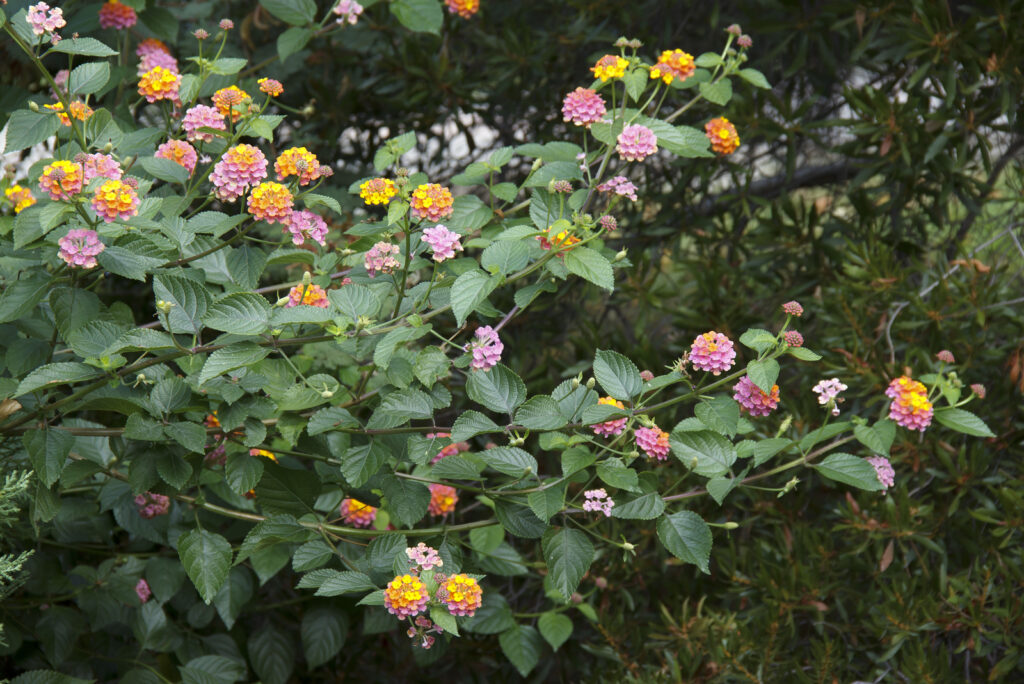Lantana — sometimes called shrub verbena — is a semi-tropical and tropical shrub that bears showy, domed clusters of bright-colored flowers. It is fast-growing and flowers last over the summer season. The flowers attract both hummingbirds and butterflies to the garden.
Lantana is often grown as a summer annual in cold-winter regions. Heavy frosts do serious damage to Lantana and can kill the plant.
There are shrubby and vining Lantana cultivars. Shrubby types can be used as foundation plants in warm-winter regions. They can also be grown in beds and containers. Grow them as annuals in cold-winter regions. Spreading or vining types can be grown as groundcovers on slopes where Lantana is hardy. Grow them in hangings baskets or as trailing plants in containers where Lantana is grown as an annual.
There are about 150 species of Lantana, but the two mentioned below are the most commonly grown and hybridized.

Get to know Lantana
- Plant type: Evergreen shrub, grown as an annual where not hardy.
- Growing zones and range: Zones 8 to 10.
- Hardiness: Frost will damage leaves and a hard freeze may kill Lantana
- Height and width: 3 to 6 feet (1-1.8m) tall and wide depending on the variety.
- Foliage: Simple, toothed, wrinkled leaves; crushed foliage has a pungent odor that some people find objectionable.
- Flowers: Showy, domed dense clusters of salverform flowers, which have a slender tube with a flared, flattened face; flowers have five lobes and are arranged in rounded or flattened heads; lantana attracts both hummingbirds and butterflies.
- Bloom time: All summer.
- Uses: Good in the border, the seaside garden, or shrub plantings; shrubby lantanas can be used as substitutes for annuals in beds or containers, as low hedges or foundation shrubs; spreading lantanas are excellent bank covers, and will control erosion; lantana is effective spilling from raised beds, planter boxes, or hanging baskets.
- Garden companions: Phlox, French hydrangea (Hydrangea macrophylla)
- Common name: Lantana, shrub verbena
- Botanical name: Lantana
- Family name: Verbenaceae
- Origin: Tropical North, Central, and South America

Where to plant Lantana
- Plant Lantana in full sun.
- Plant Lantana in well-drained, moist, fertile soil.
- In areas where they are marginally hardy, try a site against a south-facing wall for extra winter protection and reflected heat.
When to plant Lantana
- Plant Lantana in spring.
- Sow seeds indoors 12-15 weeks before the last spring frost date.
- Germination takes 6 to 8 weeks at 70° to 75° degrees Fahrenheit (21-24° Celsius).
- Soak seeds in warm water for 24 hours before sowing.
- Pinch seedlings to encourage branching.
- Transplant to the garden after the last frost date once the soil has warmed to 50° degrees Fahrenheit (10° Celsius).
Planting and spacing Lantana
- Space Lantana 3 to 6 feet (1-1.8m) apart depending on the variety.

How to water and feed Lantana
- Give Lantana moderate water.
- Water deeply during dry weather, and feed pot-grown plants monthly in summer.
- Feed Lantana lightly. Too much water and fertilizer will stifle blooms.
How to care for Lantana
- Prune Lantana hard in spring to remove dead wood and prevent woodiness.
- Prune Lantana to shape plants in late winter or early spring.
- Cover Lantana when frost threatens.
Growing Lantana as a houseplant
- Lantana camera, yellow sage, and L. montevidensis, trailing lantana, can be grown as houseplants.
- Lantana likes a wide range of temperatures and needs direct light and average humidity.
- Grow Lantana indoors in a soilless, well-drained medium.
- Keep the medium evenly moist when the plant is growing; at other times, allow it to dry slightly between waterings.
- Fertilize twice monthly when plants are growing or flowering, and monthly at other times.
- After the plants have flowered, they should be pruned back by half.
- Pinch growing tips to encourage compact growth.
Lantana pests and diseases
- Lantana can develop root-knot, rust, virus, or leaf spots.
- Lantana can be attacked by mites and whiteflies when indoors.
- Lantana fruits are poisonous is ingested.
Lantana propagation
- Take Lantana semi-hardwood cuttings in summer.
- Sow Lantana seed at 61° to 64°F (16-18°C).

Lantana varieties to grow
- Lantana camara: a tender shrub often grown as a tender perennial or warm-weather annual; grows 3-6 feet (.9-1.8m) tall; produces flat, domed, or round clusters of small, often bicolored flowers in various color combinations; leaves are ill-smelling and slightly toothed; grows well in dry or semidesert areas; it is noxiously invasive in Hawaii; this is one of two species used in hybridizing; cultivars include ‘Feston Rose’, with bicolored pink-and-yellow bloom clusters; ‘Goldmine’, with golden yellow flowers; and ‘Radiation’, with orange-and-red clusters. ‘Cream Carpet’ is a compact (1-foot (.3m) tall) selection with creamy white flowers.
- L. montevidensis, weeping lantana: a spreading, mat-forming shrub grows as a ground cover with branches trailing 3 feet (.9m) or even 6 feet (1.8m) and 10-36 inches (25-91cm) tall; bears .75-1.25 inch (1.8-3.1cm) wide clusters of .5 inch (1.3cm) blooms in shades of pink or lavender; leaves are ovate to lance-shaped and coarsely toothed leaves are dark green, 1 inch (2.5cm) long leaves with coarsely toothed edges are sometimes tinged red or purplish, especially in cold weather; this species is used in hybridizing; it is a little hardier than L. camara; rosy lilac flowers in 1-1.5 inches (2.5-4cm) wide clusters; cultivars include ‘Lavender Swirl’ is a larger form that produces lavender, white, and mixed flower clusters and ‘White Lightening’ is similar but has pure white flowers.
Lantana frequently asked questions
Q: How do I grow lantana successfully in my cold winters?
A: Lantana is a semi-tropical plant that wants average warmth with a minimum temperature of 55°F in winter. Pot it up and bring it indoors. Give the plant as much light as possible, but shade it from the noonday sun in summer. Water regularly from spring to autumn; water sparingly in winter. Indoors, mist the leaves occasionally.
Q: What is the lifespan of lantana?
A: In mild winter regions, lantana will live for several years, but can become woody after three or four years. Cut back the stems after flowering to keep the plant from getting too woody. Start new plants every two or three years.
Q: How do I start new lantana plants?
A: Sow lantana seeds in spring. Take stem cuttings at any time of the year. Seeds take six weeks to germinate. Start seeds indoors three months before the last spring frost. It is easier to start plants from rooted cutting take from your plant in the fall and grow indoors over the winter. Set the plant out in summer.
Q: I saw a small lantana tree. Is that natural?
A: No. Lantana can be trained as a standard (tree form). This involves selecting the strongest stem, and pruning away other stems and all lower foliage as the plant grows. The main stem must be tied to a stake until it is sturdy. Allow the stems and leaves to fill out at the top of the plant.
Q: How do I get lantana to bloom indoors in winter?
A: Buy small plants in summer and sink the pots in the soil out of doors until autumn. Bring the plants in before the danger of frost. Do not repot at this time. Keep the plant in a cool sunny window or plant room at not more than 60°F. Water sparingly. In spring repot in potting soil and sink the plant in the garden bed outdoors until early autumn. Winter bloom will come indoors the second year if you keep the plant pinched back.
Q: When do lantana naturally bloom?
A: Lantanas are naturally summer-to-fall bloomers.















